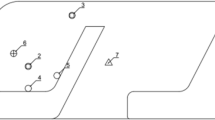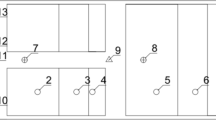Abstract
The air quality and thermal comfort strongly influenced by the heat and mass transfer take place together in an automobile cabin. In this study, it is aimed to investigate and assess the effects of air intake settings (recirculation and fresh air) on the thermal comfort, air quality satisfaction and energy usage during the cooling period of an automobile cabin. For this purpose, measurements (temperature, air velocity, CO2) were performed at various locations inside the cabin. Furthermore, whole body and local responses of the human subjects were noted while skin temperatures were measured. A mathematical model was arranged in order to estimate CO2 concentration and energy usage inside the vehicle cabin and verified with experimental data. It is shown that CO2 level inside of the cabin can be greater than the threshold value recommended for the driving safety if two and more occupants exist in the car. It is also shown that an advanced climate control system may satisfy the requirements for the air quality and thermal comfort as well as to reduce the energy usage for the cooling of a vehicle cabin.













Similar content being viewed by others
References
ASHRAE (1997) ASHRAE fundamentals chapter 8—1997 thermal comfort. American Society of Heating, Refrigeration and Air-Conditioning Engineers, Atlanta
Chakroun W, Al-Fahed S (1997) Thermal comfort analysis inside a car. Int J Energy Res 21:327–340
Kaynakli O, Kilic M (2005) An investigation of thermal comfort inside an automobile during the heating period. Appl Ergon 36:301–312
Kaynakli O, Pulat E, Kilic M (2005) Thermal comfort during heating and cooling periods in an automobile. Heat Mass Transf 41:449–458
Lin C, Lelli MA, Han T, Niemiec RJ, Hammond DC (1991) An experimental and computational study of cooling in a simplified GM-10 passenger compartment. SAE Technical papers 910216
Burch SD, Ramadhyani S, Pearson JT (1991) Experimental study of passenger thermal comfort in an automobile under severe winter conditions. ASHRAE Trans 97:239–246
Burch SD, Ramadhyani S, Pearson JT (1991) Analysis of passenger thermal comfort in an automobile under severe winter conditions. ASHRAE Trans 97:247–257
Guan Y, Hosni MH, Jones BWH, Gielda TP (2003) Investigation of human thermal comfort under highly transient conditions for automotive applications—part 1. ASHRAE Trans 109:885–897
Guan Y, Hosni MH, Jones BWH, Gielda TP (2003) Investigation of human thermal comfort under highly transient conditions for automotive applications—part 2. ASHRAE Trans 109:898–907
Kilic M, Akyol SM (2009) The effects of using different ventilation modes during heating periods of an automobile. J Thermal Sci Tech 29(1):25–36 (in Turkish)
Gagge AP, Burton AC, Bazett HD (1971) A practical system of units for the description of heat exchange of man with his environment. Science 94:428–430
Kilic M, Sevilgen G (2009) Evaluation of heat transfer characteristics in an automobile cabin with a virtual manikin during heating period. Numer Heat Transf Part A Appl 56:515–539
Sevilgen G, Kilic M (2010) Transient numerical analysis of airflow and heat transfer in a vehicle cabin during heating period. Int J Vehicle Design 52:144–159
Akyol SM, Kilic M (2010) Dynamic simulation of HVAC system thermal loads in an automobile compartment. Int J Vehicle Design 52:177–198
Maycock G (1997) Sleepiness and driving: the experience of UK car drivers. Accid Anal Prev 29(4):453–462
ASHRAE (2004) ANSI/ASHRAE standard 62–2004 ventilation for acceptable indoor air quality. American Society of Heating, Refrigeration and Air-Conditioning Engineers, Atlanta
Cheng X, Tan Z, Wang X, Tay R (2006) Air quality in a commercial truck cabin. Transp Res Part D 11:389–395
Knibbs LD, De Dear RJ, Atkinson SE (2009) Field study of air change and flow rate in six automobile. Indoor Air 19:303–313
Moffat RJ (1998) Describing the uncertainties in experimental results. Exp Thermal Fluid Sci 1:3–17
Acknowledgments
The authors would like to acknowledge for granting test equipments to Technological Research Council of Turkey (TUBITAK) under the project number 105M262, and to FIAT TOFAS for supporting the test car.
Author information
Authors and Affiliations
Corresponding author
Rights and permissions
About this article
Cite this article
Kilic, M., Akyol, S.M. Experimental investigation of thermal comfort and air quality in an automobile cabin during the cooling period. Heat Mass Transfer 48, 1375–1384 (2012). https://doi.org/10.1007/s00231-012-0988-8
Received:
Accepted:
Published:
Issue Date:
DOI: https://doi.org/10.1007/s00231-012-0988-8




